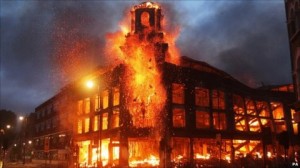Riots and Complexity
By Paul Ormerod
What can complex systems and network theory tell us about the riots we have just witnessed?
There was clearly a great deal of copying going on, of imitating other people’s behaviour. This was both within a given community and across communities. Social network media did not cause this, they facilitated it. The incidents received much wider coverage in the traditional media.
 But ex ante, it is extremely difficult to predict which events will give rise to ‘cascades’ across networks in this sort of way. Which events will lead to general riots, which will lead to local disturbances, and which will experience no problem at all.
But ex ante, it is extremely difficult to predict which events will give rise to ‘cascades’ across networks in this sort of way. Which events will lead to general riots, which will lead to local disturbances, and which will experience no problem at all.
This is a key insight of network theory. Networks are ‘robust yet fragile’. They are robust in the sense that most shocks, most bits of new information, most events are contained by the network, and their influence does not spread. But they are at the same time fragile, in the sense that an incident similar to others which have not spread, suddenly gets traction and spreads.
There are lots of examples of perceived police insensitivity towards minority communities, real or imagined. But in general these do not lead to widespread looting in British cities. There was nothing unique about the shooting of Mark Duggan, and his immediate family called for calm. But in this instance, the network was fragile. Rioting and looting spread.
Once an event happens, however, whenever copying or imitating the behaviour of others across networks is important, it becomes easier to predict whether it will really take off. The complex network structure which makes ex ante prediction very hard, paradoxically makes it easier to assess the eventual scale of the outcome than it would be if networks were not present. So, for example, early diffusion of activity across different communities is a much more powerful predictor than the initial scale of activity. Sometimes, locally large disturbances remain confined and do not spread.
Finally, although a key insight of network analysis is to break the common sense link between the size of an event and its eventual outcome, it is only broken in part. We now know that in networks, small events can have large consequences. This is where ‘common sense’ breaks down.
But a large event still has large consequences. So when riots and looting spread, you have two strategy options. First, to try lots of different small scale interventions and see if one of them takes off, if it is able to exploit the fragile property of networks. Second, to do something on a dramatic scale. For example, call in the Army and shoot 20 looters dead. But what you do not do is what it appears the police did, which was to be reactive only, not proactive. And if you want to follow the first option, time is of the essence. You want to experiment, so you had better do your experiments very quickly before the looting spreads out of control.
